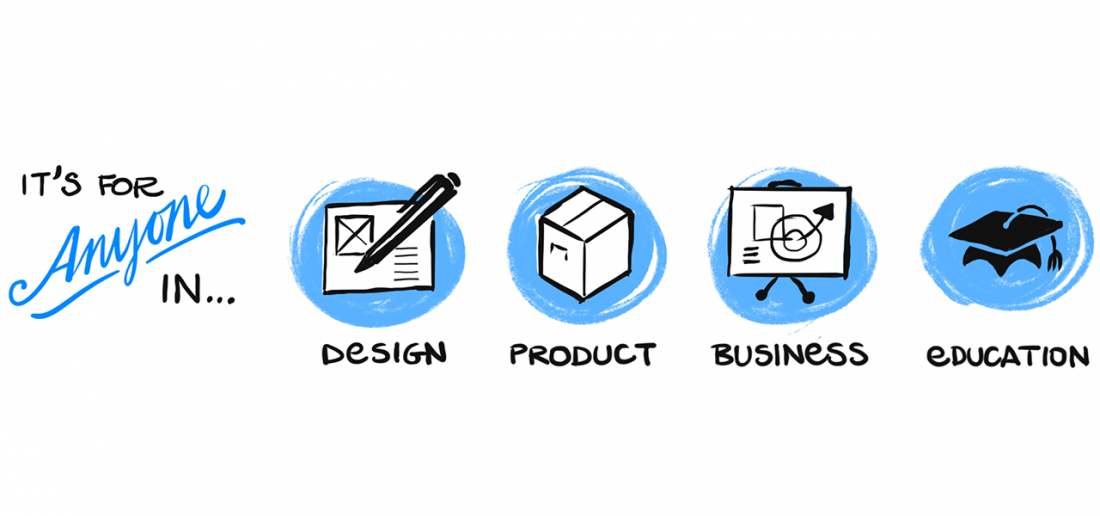Spotlight on Scribing | An interview with Devon Bunce
Ben Crothers interviews Devon Bunce for a chapter in his book, Presto Sketching.
Read the interview below…
Devon is a freelance graphic facilitator with a rich and varied education in her field. Here, she shares what it means to transform a group’s conversation into a tangible meaningful object.
Visual communication is an alternative language that creates space for multiple meanings and interpretations. When I’m scribing, I think about creating that space for all of the voices in the room to exist, and for me to be as neutral as possible (I don’t believe in total neutrality).
I first learned about visualization from Grove in San Francisco, a consultancy that uses visual environments to help a group move forward and have a better conversation. I also learned a toolkit for visual language, from a Danish company called Bigger Picture, which included simple objects like signposts and arrows. But there was more to it than just scribing technique; I learned a lot about listening, leadership, and personal development through Kaospilots, my education in Denmark.
I committed to taking my notes visually. I got a blank notebook without lines, picked four colors I liked, and just started doodling. Oh, and gray! Discovering grays was a really poignant moment for me. Shadows added dimension to my drawings. It really stood out for me!
I realized over time that I listen a lot better when I doodle. There are three levels of listening. The first level is listening and interpreting what the content means to me. The second level is listening with an attentive focus on another person. The third level of listening is about paying attention to the whole group, the environment they’re in, and what is happening to the energy in the room. Third-level listening incorporates your intuition, and can also be seen as supporting a third entity: what is seeking to emerge in this space? And how can I best support what is seeking to emerge?
I’m really into the idea of engaging with the whole of my body. My work at Global Leadership Foundation has taught me about the three brains in the body, also referred to as “centres”: the head gives us insight, the heart gives us intuition, and the gut gives us instinct. Usually we rely on just two of those centers at a time, but the key is to use all of them. When you’re engaging with all three of these centers you’re present, you’re in flow. When I find this flow, I’m able to remain focused and engaged throughout conversations that can span multiple days.
The pictures I draw help participants relate to content differently, and spark new perspectives and opportunities for thinking differently. Introducing visual language to a conversation gives permission to expand the way we are doing things. And seeing the progression of thinking, conversing and activity amongst a group mapped out in a collective journey creates a sense of oneness. The illustration brings content to life in a playful way. It allows us to access our heart center.
When I’m working, I’m trying to pay attention to what is emerging in me, or what is igniting something in me based on my own experiences, and what I see to be important, versus what might be relevant for the group. I’m often asked about the process of making a choice about what to visualize and record, and this is where attention to the third entity is required. However, I must admit that it can be easy to get swept into the emotion of a conversation when the subject is American politics!
Figure 12-11. Devon on the pens, hard at work: “The pictures I draw help participants relate to content differently, and spark new perspectives and opportunities for thinking differently.”
This is something that’s really important to me. It’s so important to continuously think: how can I be in service of what is seeking to emerge in the room, rather than just me? As you scribe, you will have an engaged body center. So, aim to pay attention to when the other centers, the head and the heart, are dominating the airwaves. It’s about being in balance. That’s when I’m at my best. That’s when I’m present, I’m in flow. I’m just exactly where I am.
It’s so important to continuously think: how can I be in service of what is seeking to emerge in the room?
Buy his book, “The Magic of Simple Drawing for Brilliant Product Thinking and Design” on Amazon. “Packed with step-by-step examples, Ben’s book can make you a better communicator through simple sketching.” – Mike Rohde, bestselling author of The Sketchnote Handbook and The Sketchnote Workbook

